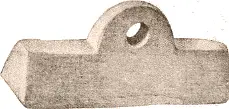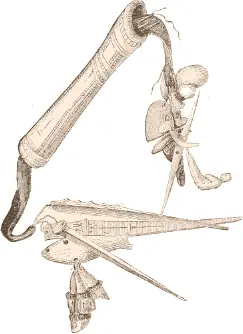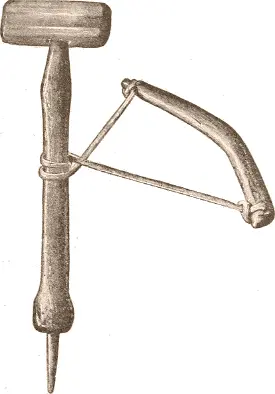
Fig. 469. Stretcher for lines. (National Museum, Washington. 9836.) 1/1
Another kind of line is cut from the hide of the white whale, which is skinned in the same way as the ground seal, but, as it must be slit on the spinal column, the single pieces of line are much shorter, and they cannot be used to the same extent as seal lines. Some lines are cut from the skins of Pagomys fœtidus , but these are weak and greatly inferior to lines of ground seal hide.
Deerskins are dried in summer and dressed after the ice has formed. Like all other kinds of skins they are not tanned, but curried. They are hung up among the rafters of the hut, and the workers—in Oqo and Akudnirn the women, in Hudson Bay the men—take off their jackets and begin preparing them with the sharp scraper. After being cleaned in this way they are thoroughly dried, either by hanging them near the roof of the hut or, according to Gilder, by wrapping them around the upper part of the body next to the skin, after which they are again scraped with the tesirqun. This done, the flesh side is wetted, the skin is wrapped up for half a day or a day, and afterwards undergoes a new scraping. Then it is chewed, rubbed, and scraped all over, thus acquiring its pliability, softness, and light color.
In the spring the skins of bears and of seals are sometimes dried on large frames which are exposed to the sun, the skins being tied to the frames with thongs. Smaller quadrupeds, as foxes and ermines, are skinned by stripping the entire animal through its mouth without making a single cut in the skin. Birds are opened at the breast and the body is taken out through this small hole, the head, wings, and legs being cut off at the neck and the other joints. Ducks are frequently skinned by cutting the skin around the head and the outer joints of the wings and legs and stripping it off. The skins are cleaned by sucking out the fat and chewing them.
Skins of salmon are used for water proof bags; intestines of seals, particularly those of ground seals, are carefully dried and after being sewed together are used for sails, windows, and kayak jackets.

Fig. 470. Ivory needle. (National Museum, Washington. 34135.) 1/1

Fig. 471. Ivory needle case from Cumberland Sound. (Museum für Völkerkunde, Berlin. 6832.) 1/1

Fig. 472. Common pattern of needle case. Iglulik. (From Parry II, p. 548.)
Table of Contents
The sewing is done with thread made of deer or white whale sinews. Particularly are those sinews at the back dried and when intended for use they can easily be split as thin as required. At present steel needles are in general use. Wherever they are wanting ivory ones of the same pattern are used (Fig. 470). The thread is fastened to the eyehole by a kind of loop, the short end being twisted around the longer one. Kumlien described a needle of a very different device (p. 25):
This tool was almost exactly like an awl in shape, but had an eye near the point. They must have had to thread this instrument for each stitch. The needle part was apparently of deer horn and the handle of walrus ivory.
Probably it was used like a packing needle for sewing tent covers, &c. The needles (mirqun) are kept in ivory needle cases (umī´ujang). The case represented in Fig. 471 is from a grave in Cumberland Sound. The grooves on both sides are evidently intended for a leather strap which is to be tied around it. This specimen is closed at the bottom and had a stopper for closing the mouth. Fig. 472 is a more common pattern. The ivory piece forms a tube through which a leather strap passes. The needles are stuck into the leather and drawn into the tube. Small ivory implements and ornaments are attached to both ends of the strap.

Fig. 473. Tikiq or thimble. (National Museum, Washington. 10181.) 1/1
Thimbles (tikiq) (Fig. 473) are made of an oblong piece of ground sealskin, fitting to the point of the first finger. A rim is cut around half of its circumference and thus it can be drawn over the finger. The women sew by pulling the thread toward them and making an overcast seam.
Whalebone is used for making elastic thongs and in the place of wood; for example, for kayak ribs, for the rim of the kayak hole, boxes, &c. It requires no particular preparation, being easily split and shaped so as to fit any purpose. If wood is to be bent into hoops or deer horn is to be straightened, it is made pliable by being put into boiling water for some time. Bones of whales and other large animals and the penis bone of the walrus are used instead of poles. In olden times, when iron was extremely rare and an effective saw could not be procured, they split the bone by drilling many holes, one close to the other, afterwards breaking the pieces asunder.

Fig. 474. Instrument for straightening bones.
Small pieces of bone, used for arrows &c., were straightened, after being steamed, with the implement represented in Fig. 474.

Fig. 475. Drill for working in ivory and bone. (National Museum, Washington. 34114.) ⅔
The drill (Fig. 475) is the most important implement for working in ivory and bone. It consists of three parts: the bow with its string (niuqtung), the drill (qaivun), and the mouthpiece (qingmiaq). The string of the bow is twisted around the shaft of the drill, the mouthpiece (which is made of wood or of bone) is taken into the mouth, and the rounded end of the drill is placed in its hole. Then the whole implement is put firmly against the place to be perforated and is set in motion by moving the bow. Instead of the latter, a string is sometimes used with a handle at each end. For one man, however, the first device is handier. The string of the second form is usually pulled by one man while the other holds the mouthpiece.
The same instrument is sometimes used for making fire. Instead of the iron, a piece of hard wood (ground willow) is put into the mouthpiece and placed upon a piece of driftwood cut to the shape represented in Fig. 476. The wooden drill turns rapidly in a hole of the driftwood until it begins to glow. A little moss is applied to the glowing wood and gently blown until it begins to burn. Wherever flint and pyrite are to be had these are used for striking fire. Moss or the wool-like hair of Eryophorum serves for tinder.

Fig. 476. Driftwood used in kindling fire from Nugumiut. (National Museum, Washington. 10258.) ¼
Читать дальше




















